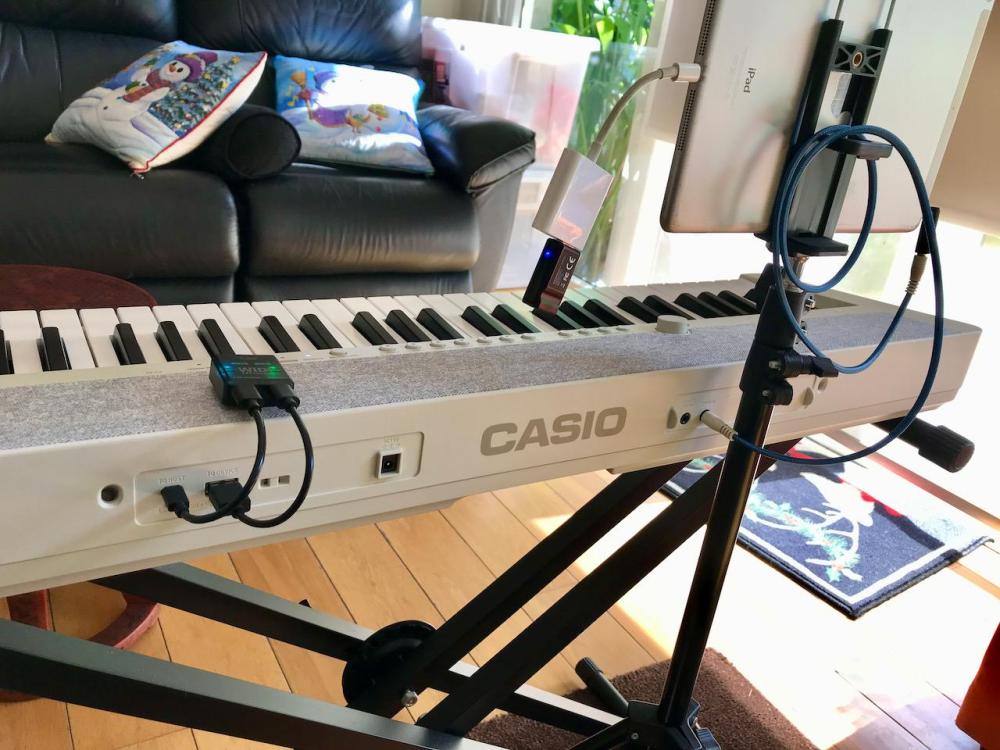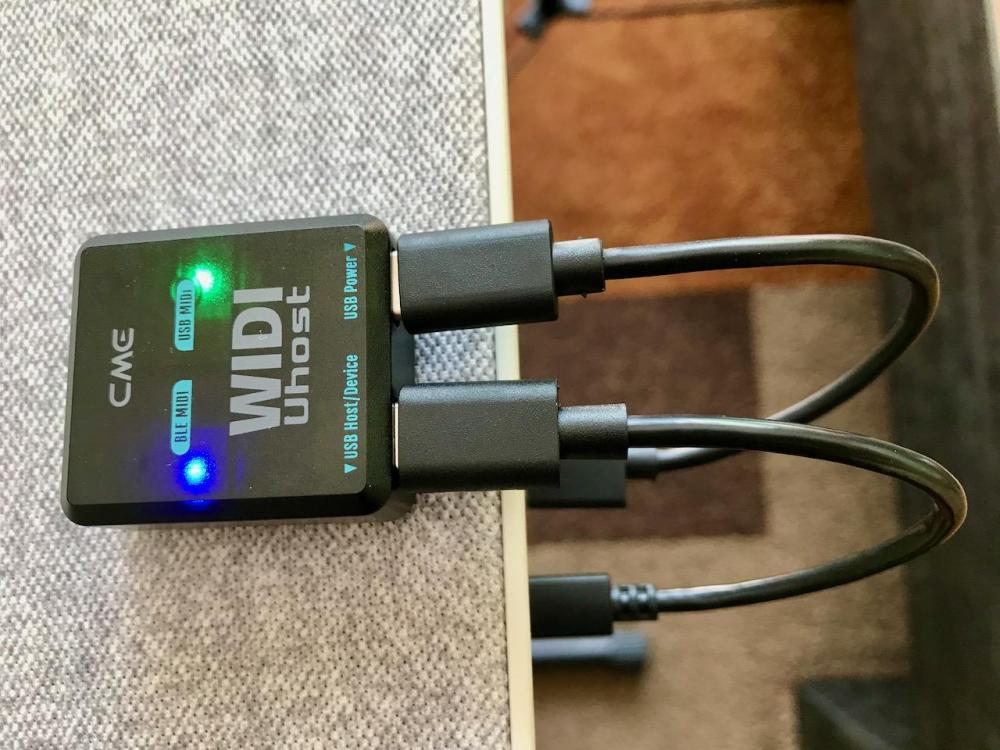-
Posts
17 -
Joined
-
Last visited
Recent Profile Visitors
The recent visitors block is disabled and is not being shown to other users.
Groove On's Achievements
-
Program Change a program change is a technical way of saying "change the sound". when you press a button on your CT-X800 and it switches to an organ sound, you've sent a "program change" in other words, you changed the sound it was using. you can also send a program change with Presonus Studio One. Look in your keyboard's manual for the program change codes for each sound. note - "program change" might be shortened to "PC". Bank you might also hear the word "bank" which is like a "category" for sounds. there might be a bank for piano sounds or a bank for organ sounds. Here's the instructions for sending bank/program changes in Presonus Studio One. https://support.presonus.com/hc/en-us/articles/210040493-MIDI-Bank-Program-Change-External-MIDI-Hardware-Devices-
-

Using Old or Alternate OSes With Your Gear
Groove On replied to cooltouch's topic in General Casio Discussion
For Linux, the Raspberry Pi 4 is an interesting alternative for studio recording. My main machine is a Mac, but I'm using a Raspberry Pi 4 for recording in Reaper and the slightly faster Odroid N2+ as a Pianoteq sound module. The processors aren't super powerful, so you really want to dedicate each small board computer to 1x specific music task. These small board computers all run off SD cards, so dual-booting just means means switching out the boot cards. Some caveats: - it is a completely different computing experience; tweaking and optimizing means using the command line interface, digging into the OS guts and occasionally even dealing with code. But the Raspberry Pi 4 has a huge community of enthusiasts, so it's one of the best boards to for getting into Linux - if you're inclined. - most commercial software developers have shown zero interest in porting their software to Linux (there are good reasons for this), you can literally count the commercial audio programs on your hands. And while there are a lot of good open-source options, you'll find the general software quality is lower than in the Windows/Mac world. -
No, the hardware controls on the CT-S1 do not change. Any external MIDI sent to the CT-S1 only affects the 2nd sound engine. The hardware controls on the CT-S1 are connected to the primary sound engine (Local Control); and the primary sound engine does not respond to MIDI IN. If you want the hardware controls to change, you would have to send external MIDI to the primary sound engine (Local Control); but, AFAIK there is no way to do this on the CT-S1. In other words, if you want to send MIDI to the CT-S1, you'll only be working with the 2nd sound engine - and none of that is connected to the onboard hardware controls.
-
To send program changes to the CT-S1, I'm using Midi Pad 2 on the iPhone. Super simple and easy to setup. US$2.99 on the App Store. https://midipadapp.com. I can also send program changes via MainStage (MacOS) and Camelot (iPad OS). All those apps work with wired USB or Bluetooth. The main issue with sending program changes to the CT-S1 is that external MIDI is only sent to the 2nd sound engine. So if you want to use the local CT-S1 keyboard to play/hear the program change, you need to route the MIDI OUT and back to MIDI IN (where the 2nd sound engine is listening). Apps like MainStage or Camelot can take the MIDI OUT from the CT-S1 keyboard and send it back to MIDI IN (so that the 2nd sound engine responds). This is pretty fast, but does add a bit of round-trip latency. The fastest/easiest setup (and my current setup) is to use the WIDI UHost from CME. It connects directly to the CT-S1 via USB but can still receive program changes via Bluetooth. The UHost has a feature called "USB Soft Thru"; it takes the USB MIDI OUT from the CT-S1 keyboard and immediately routes it back to USB MIDI IN, so I can actually play the program changes and I don't need a full-blown computer to do it - a second advantage, it's very low latency. *** This is a feature that Casio should add to the WU-BT10 Bluetooth Adapter ***. In the attached photos, I can send program changes via Bluetooth from the iPad to the CT-S1. When I play the keys, the WIDI UHost re-routes the USB MIDI OUT immediately back to USB MIDI IN so I can hear the program change from the 2nd sound engine.
-

New Teaser? Check It Out / Are You Ready?
Groove On replied to Akshansh - Alex's topic in General Casio Discussion
Well I'm excited. Loving the red panel color, I like that it's another Casiotone. The question is what kind of Casiotone? 🙂 -
FYI - CME added a MIDI Thru on their USB Bluetooth devices. The setting is called "USB Soft Thru" and it works on the Casio CT-S1. When ON, the local MIDI OUT from the CT-S1 keyboard will be routed THRU to the second MIDI sound module that only responds to External MIDI IN. So you can send Program Changes to the CT-S1 and immediately start playing the second MIDI sound module with the local keyboard. Big benefit, latency is very fast, no more long round-trips to the computer. It will be very useful for multi-keyboard set lists in Main Stage, Camelot Pro, On Song, KeyStage etc. - where we might send multiple Program Changes, Splits and Layers and immediately want to play the local CT-S1 keyboard. Perhaps this is something the Casio could also add to the WU-BT10. It's a very useful feature.
-
Portable and completely battery-powered. Two stands and some wires.
- 1 reply
-
- 2
-

-
This is a good match for the Casio CT-S1; and it's a fun setup to mess around with. The retro look feels like a 70's garage rig and it's very travel friendly. Electric pianos, organs and synths sound good; unfortunately pianos sound "boxy" through this amp - so that's one compromise to consider. My other choice was the IK Multimedia 40 watt iLoud speaker - with a built-in battery; but I really like that the Vox is more of a pro-audio amp with a built-in mixer, 1/4" jacks for inputs, mic and line out - plus 1/8" jacks for aux-in and headphone jack.
-
That's cool. I like the way you colored the headers with black/white to show which key to use. 😃
-
I'm wondering what real-world instruments the CT-S1 organs are based on. Does anyone know or have a guess? Jazz Organ (Hammond?) Velo. Organ Rock Organ Pipe Organ Amp Organ Reed Organ (Wurlitzer?) Gospel Organ F-Organ (Farfisa?) V-Organ (Vox Continental?) Cathedral Organ
-
Groove On changed their profile photo
-
I owned the Roland Go Piano for 3 years. Form factor was great for schlepping around the world to different countries (I’m retired, not a professional). But the Go Piano action really wore on me, like a pebble in your shoe. Eventually just stopped using it and sold it because of the action. I’ve had the CT-S1 for around 3 weeks. The CT-S1 has decent dynamic control and I find myself reaching for it more and more just for the fun of it, something I stopped doing with the Go Piano. Don’t let your imagination run away, it’s still a plastic US$199 action, but the action is decently playable. I won’t buy another Go Piano, but I’m considering getting a 2nd CT-S1.
- 1 reply
-
- 2
-

-

PX-S1100 and PX-S3100 announced (July 2021)
Groove On replied to rsaintjohn's topic in Privia PX-S Series
I do like that the WU-BT10 Bluetooth adapter is included with both the PX-S1100 and PX-S3100. That’s also interesting about the audio recording/playback feature. I assume that’s through the USB port as well. PX-S1100 https://www.casio-intl.com/asia/en/emi/products/pxs1100/spec/ PX-S3100 https://www.casio-intl.com/asia/en/emi/products/pxs3100/spec/ -

PX-S1100 and PX-S3100 announced (July 2021)
Groove On replied to rsaintjohn's topic in Privia PX-S Series
I really like what Casio has been doing, but it's too bad they took out the 3.5mm AUDIO IN on the PX-S1100. That's a very useful feature that I use every day; so for me, it went from a "must buy" to a "wait and see". But still after getting a CT-S1, I'm paying a whole lot more attention to the Casio keyboards. I'm hoping we see a 61-key version of the PX-S line. -
I made a one-page quick guide for myself, so it's easier to remember some basic functions. Formatted for A4 or 8.5x11" paper.




